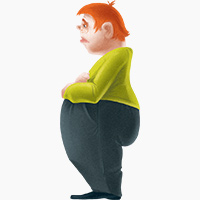Ancient bodies, modern world
The human genome didn’t undergo any drastic fat-storing mutations around 1990. But the obesity rate has skyrocketed in the past 20 years, reaching almost 36% in 2010. The problem isn’t our bodies – physiologically, we’re the same as we always were. The problem is the disjunction between the world we evolved to thrive in and the world we actually have to deal with.
Evolving in a premodern food environment forced our bodies to adapt to an inconsistent food supply. We’re very good at storing fat, because for most of human history, our next meal was a lot further away than a trip to the Quickie Mart. Fat storage allowed us to stock up on food when it was available, and use those reserves during periods of scarcity. A biologically hardwired taste for fat and sweetness directed us to calorie-dense foods when they were available, maximizing our energy intake to prepare for lean times ahead.
Back in the day, these adaptations ensured the survival of the species – without them, we wouldn’t be here at all. Unfortunately for us, our food environment has changed faster than our bodies can keep up. We’re adapted for food scarcity, but confronted with overabundance and the constant struggle to limit our consumption. At the same time, these foods lack in nutrition what they provide in calories, so we gain weight even though we’re also malnourished! Talk about a double whammy!
Paleo helps many people lose weight because it re-creates the food environment that we evolved for. Some people accomplish this effortlessly. They cut out the “heart healthy whole grains” and the weight seems to melt off faster than they can buy new jeans. But others struggle with their weight even after the switch – and some people initially see great success but then plateau. Putting so much effort into a healthy diet and regular exercise only to see no results can be incredibly discouraging. But whether you’re just starting and frustrated at your lack of progress, or stuck in a plateau after a few months of success, there are many ways to optimize a Paleo diet for healthy, sustainable weight loss.
In this article, you’ll get a look at how weight loss works, why it’s hard, and what you can do about it.
You are not a bomb calorimeter
To lose weight with a minimum of pain and suffering, it helps to know exactly how weight gain (and loss) works in the first place.
There’s a camp fond of (very vociferously) claiming that weight loss is a simple math equation: calories in vs. calories out. Just eat less, and move more, and you’ll be all set: if it doesn’t work, you’re just not cutting calories hard enough. It’s technically true that calories determine weight gain or loss. But in the real world, the way to achieve sustainable, long-term weight loss is not to start cutting or counting calories.
First of all, this theory doesn’t distinguish between calories that are nourishing and calories that are harmful. Yes, you’ll lose weight on 1,200 calories of Doritos every day, but you’ll also develop severe digestive problems and micronutrient deficiencies that do much more damage to your health than the weight loss repairs.
More importantly, “calories in/calories out” doesn’t account for nutrient partitioning. “Nutrient partitioning” refers to the way calories are used in your body: are they burned for energy, or are they stored as fat? If two people each eat a bagel, and one of them burns the calories to keep her body temperature up while the other stores them as fat, then technically they’ve both proven the laws of “calories in, calories out,” but with very different results!











